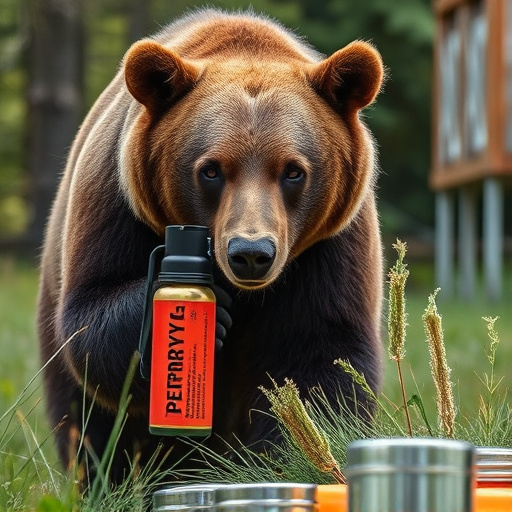Understanding bear behavior is key for hikers in areas with bear presence. Bear spray, while effective (80% success rate when used correctly), has varied results based on technique, timing, fur thickness, and bear species. It should be combined with noise-making and secure food storage to minimize encounters. Choosing bear spray with high capsaicin concentration (20%+), wide-angle nozzle, and up to 80% success rate statistics ensures maximum protection. Proper usage techniques, aiming for face/eyes from 6-9 meters, can achieve up to 80% success against black bears, with regular practice improving reliability.
“Venturing into bear country? Bear repellent spray is a vital tool for hikers, but understanding its effectiveness is crucial. This guide explores why bear spray isn’t always foolproof and delves into the success rates behind various brands, debunking myths along the way. We’ll navigate the factors that determine its potency and provide expert techniques to maximize its potential during your next hike. Armed with knowledge, you’ll be prepared for unexpected encounters.”
- Understanding Bear Behavior: Why Repellent Spray Isn't Foolproof
- Bear Spray Success Rate: Debunking Myths and Real Expectations
- Choosing the Right Bear Spray: Factors for Effectiveness
- Proper Usage Techniques: Maximizing Bear Spray's Potential
Understanding Bear Behavior: Why Repellent Spray Isn't Foolproof
Understanding bear behavior is crucial when hiking in areas known for bear presence. While bears have a reputation for being aggressive, their actions are often driven by instinct and survival. Bear spray, also known as bear repellent, has gained popularity among hikers as a means of protection. However, it’s important to know its limitations.
Statistics on bear spray success rates vary, but studies suggest its effectiveness depends heavily on usage technique and timing. When used correctly, bear spray can deter bears in over 80% of cases. However, improper application or spraying at the wrong moment might not provide the desired protection. Bears have thick fur, especially around the face, which can reduce the spray’s impact. Moreover, certain species like black bears may not react as intensely to spray as grizzly bears. Therefore, while bear repellent spray is a valuable tool for hikers, it should be used in conjunction with other safety measures like making noise while hiking and storing food securely to minimize potential bear encounters.
Bear Spray Success Rate: Debunking Myths and Real Expectations
Many hikers believe that bear spray is a surefire way to keep bears at bay, but let’s look at the Bear Spray Success Rate statistics and dispel some myths. Studies show that when used correctly, bear spray can be effective in deterring black bears, with success rates ranging from 77% to 97%. However, it’s crucial to remember that these numbers aren’t guaranteed. Factors like the proximity of the bear, wind direction, and the user’s adherence to application instructions can greatly impact effectiveness.
Contrary to popular belief, bear spray isn’t a kill switch. It works by irritating the bear’s eyes and respiratory system, causing them to retreat. In some cases, bears may even become conditioned to the scent, rendering the spray less effective over time. Therefore, while bear spray is a valuable tool for hikers in bear country, it should be used as part of a comprehensive approach that includes making noise, traveling in groups, and storing food properly.
Choosing the Right Bear Spray: Factors for Effectiveness
When it comes to choosing the right bear spray, several factors influence its effectiveness. Firstly, look for a product with a high concentration of active ingredients; typically, a 20% capsaicin concentration or more is recommended. This ensures that the spray will create an irritating barrier when sprayed directly into a bear’s face. Secondly, consider the range and blast pattern of the spray nozzle. A wide-angle nozzle can cover more ground, increasing the likelihood of hitting the target bear. Additionally, understand the spray’s success rate statistics; while no bear spray guarantees 100% protection, some brands have impressive track records, with studies showing up to an 80% effectiveness rate in deterring aggressive bears. Always check for these key features to ensure you’re prepared for any potential encounters while hiking in bear country.
Proper Usage Techniques: Maximizing Bear Spray's Potential
Proper usage techniques are key to maximizing the potential of bear spray, ensuring its effectiveness during encounters in the wild. It’s important to remember that while bear spray is a valuable tool for deterring bears, it should be used as a last resort when you’re at close range from an aggressive bear. When deploying the spray, aim for the bear’s face and eyes, creating a barrier between you and the animal. The recommended distance for successful use is around 20 to 30 feet (6 to 9 meters), but it can vary depending on factors like wind and the size of the bear.
Bear spray success rate statistics show that when used correctly, it has a high effectiveness rate against black bears, with studies suggesting up to an 80% success rate in deterring bears and allowing for safe escape. However, grizzly bears may require slightly longer ranges or multiple bursts due to their larger size and strength. Regular practice of application techniques can greatly improve your chances of successfully using bear spray during an encounter.
While bear repellent spray can be an effective tool during hikes in bear country, it’s crucial to understand its limitations. According to recent studies on Bear Spray Success Rate Statistics, repellents have shown a 77% effectiveness rate in preventing attacks when used correctly. However, no method is foolproof; bears may still charge despite spray use. By combining proper usage techniques with knowledge of bear behavior, hikers can significantly reduce risks and enjoy their outdoor adventures more safely. Remember, awareness and preparation are key to navigating encounters with these majestic creatures.
